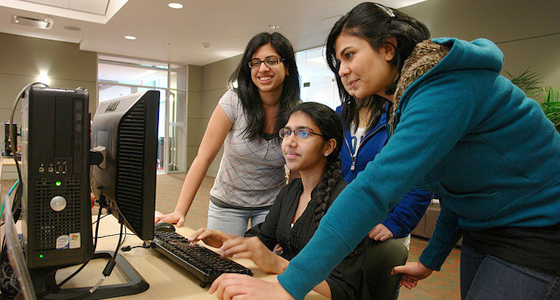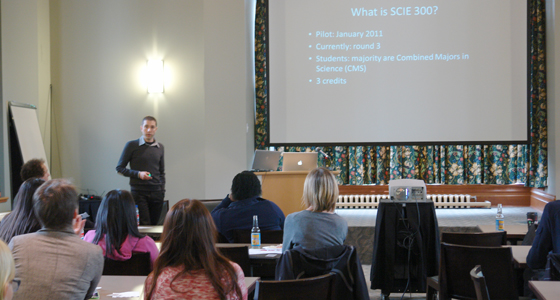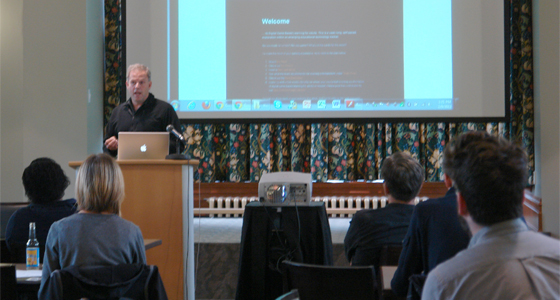 Imagine a classroom in which the students are the teachers. They get to choose the subject, create the syllabus and are responsible for the course content. This is a reality. In post-secondary education the classroom is constantly changing and students are taking an active role in creating their own learning environments. Students are not only consumers of knowledge; they actively contribute to the teaching and learning at the university. In the Teaching, Learning and Technology Series’ presentation, Students as Creators and Producers, three speakers were invited to talk about their innovative and interactive UBC courses – where students are creators of content and producers of knowledge.
Imagine a classroom in which the students are the teachers. They get to choose the subject, create the syllabus and are responsible for the course content. This is a reality. In post-secondary education the classroom is constantly changing and students are taking an active role in creating their own learning environments. Students are not only consumers of knowledge; they actively contribute to the teaching and learning at the university. In the Teaching, Learning and Technology Series’ presentation, Students as Creators and Producers, three speakers were invited to talk about their innovative and interactive UBC courses – where students are creators of content and producers of knowledge.
The SDS Program: Students as Facilitators
 The first presenter was Erin Biddlecombe, the Student Development Officer for the Student Directed Seminars (SDS) Program at UBC. The program gives senior undergraduate students from all Faculties the opportunity to initiate and facilitate a three credit course. This program is the only one of its kind in Canada. It gives students the chance to take education into their own hands and create a course for their peers.
The first presenter was Erin Biddlecombe, the Student Development Officer for the Student Directed Seminars (SDS) Program at UBC. The program gives senior undergraduate students from all Faculties the opportunity to initiate and facilitate a three credit course. This program is the only one of its kind in Canada. It gives students the chance to take education into their own hands and create a course for their peers.
The SDS application requires students to create a proposal and find a faculty member willing to sponsor and help them develop their course. Once chosen, applicants must create a course plan, syllabus, and reading list, as well as market their class. The student facilitators are given training and time to prepare their course during the first term and typically facilitate the seminar in January. The course consists of a three-hour seminar, once a week, with small class sizes of 8-15 people.
Erin stresses that Student Directed Seminars have a heavy workload and that students who become facilitators tend to have a higher grade point average. However, it is worth the extra work because the students get to take charge and initiate discussions with guest speakers and peers. They gain meaningful leadership and managerial skills for future job applications, as well as a beneficial learning experience while working closely with faculty members. Furthermore, the course is worth three credits and is the only UBC course in which students receive a notation on their transcripts recognizing their work as student facilitators.
Justin McElroy, a former student facilitator and the Coordinating Editor of the Ubyssey newspaper wrote an article about the SDS Program calling it “the best UBC program you’ve never probably heard of.” His article emphasizes that students “get to take direct control of [their] educational experience – at least for one course.” Justin’s seminar, Journalism in the 21st Century, was the only upper-level journalism course offered to undergraduate students. It was a great success and gave students an opportunity to take a course that they would not have been able to take, had it not been a SDS course.
SCIE 300: New Media Influence
 Eric Jandciu is the course coordinator for SCIE 300: Communicating Science, a new and highly interactive course that aims to promote scientific communication skills. This is a multi-section course that focuses on actively engaging the science community; students are required to attend large lectures, small discussions, and contribute to an online community. The class has a private blog that students regularly add posts to. Students are encouraged to include their personal opinions into their posts and generate conversation with one another. The blog is closed to the public, but creates a centralized learning space for the course.
Eric Jandciu is the course coordinator for SCIE 300: Communicating Science, a new and highly interactive course that aims to promote scientific communication skills. This is a multi-section course that focuses on actively engaging the science community; students are required to attend large lectures, small discussions, and contribute to an online community. The class has a private blog that students regularly add posts to. Students are encouraged to include their personal opinions into their posts and generate conversation with one another. The blog is closed to the public, but creates a centralized learning space for the course.
Blogging is a major component of SCIE 300, and for many students it is their first experience using a blog. Eric ties in the importance of blogging to the real world by giving students examples of academically acknowledged scientists who have recorded data and research via blogs. Even though there is a steep learning curve, when learning how to navigate the back end of a blog, students have generally embraced this form of new media. They have taken blogging seriously and some have even wanted a greater portion of their grade to go towards their posts.
The final assignment for SCIE 300 is to work in small groups and create a five-minute video and podcast of an interview with a UBC research scientist. Students are given a choice of researcher papers at the beginning of the course. After selecting a topic, the students are responsible for researching the topic and creating a narrative and dialogue for the video. Students must also choose the setting where they want to film the interview, and select questions to ask the researcher. The final project is then uploaded on the course blog to be reviewed.
According to Eric, the students have exceeded expectations with their videos. They are given little guidance and have succeeded in creating and editing a video and podcast, and posting it to their blogs. This hands-on experience with technology and media has given students the chance to be creative and have relevant experience for employment. The final project shows that students actively creating their education have had positive experiences leading to transformation and fulfillment in the course content.
ETEC 522: An Open Online Course
 The final presenter shared a similar view to Eric, that technology and changing classrooms are essential for higher education. David Vogt is the instructor for the Master of Educational Technology course ETEC 522: Ventures in Learning Technology. This highly interactive online course explores entrepreneurial ventures involving learning technology.
The final presenter shared a similar view to Eric, that technology and changing classrooms are essential for higher education. David Vogt is the instructor for the Master of Educational Technology course ETEC 522: Ventures in Learning Technology. This highly interactive online course explores entrepreneurial ventures involving learning technology.
The course takes place on a WordPress site and consists of student posts, in which they take on the role of analysts and entrepreneurs. The website is open to the public and encourages students to only publish their best work. In one example, a student wrote a review on a paper about advances in teaching technology. Within a week, an individual outside of the class wrote a response to the student’s article. In ETEC 522, the students are interacting not only amongst themselves, but also with the wider world. ETEC 522 is an intense course, with 40 students publishing 30-40 posts per semester. In this setting, David suggests that students create a better learning experience for themselves and others.
ETEC 522 has been a success and students have had positive feedback regarding it. David credits this acclaim to the student’s participation in the course. The students choose the topics of the course (different emerging technologies) through online surveys. The surveys match students into groups based on their preferences. For the final assignment, each group pitches their emerging technology to the rest of the class. In addition, David noted that the participation mark (25% of the overall grade) is largely influenced by the students. Students are told to take interesting things that they had said and done in posts, and give themselves a grade for their participation. More often than not, David finds that the students’ grades match up with the participation mark he gives them.
In the article, Student Content Creators: Convergence of Literacies, Joan Lippincott argues that “higher education needs a new framework for promoting the value of information and technology skills.” She points out that there is “evidence that students are creating all types of digital content” and “when they graduate from universities and colleges and enter such fields as business, education, government, research or the arts, they will continue to produce digital content.” She encourages faculty to embrace technology and student contributions, just as Erin, Eric, and David have done in their courses.
Lippincott addresses the many values of interactive and student produced projects. For instance, the students creating a video for SCIE 300 need a variety of skills to accomplish the task. They must research the topic, develop a script, create visuals, and produce and edit the video. These are all valuable opportunities for students to learn and develop their creativity, and hone their research and writing skills. She stresses that universities need to acknowledge the “shift in how we produce content today” and “assist students in becoming sophisticated digital-content producers in their professional lives.”
UBC is a leading university for new and innovative classrooms. The three initiatives described above are examples of courses that embrace students as creators of content and producers of knowledge. These courses create unique learning environments where students get the opportunity to contribute to their own education. Students gain invaluable experience as peer leaders and content creators, and get hands-on experience using new and emerging technologies. These interactive courses, where students take more control of their education, are visions of the future of higher education.

